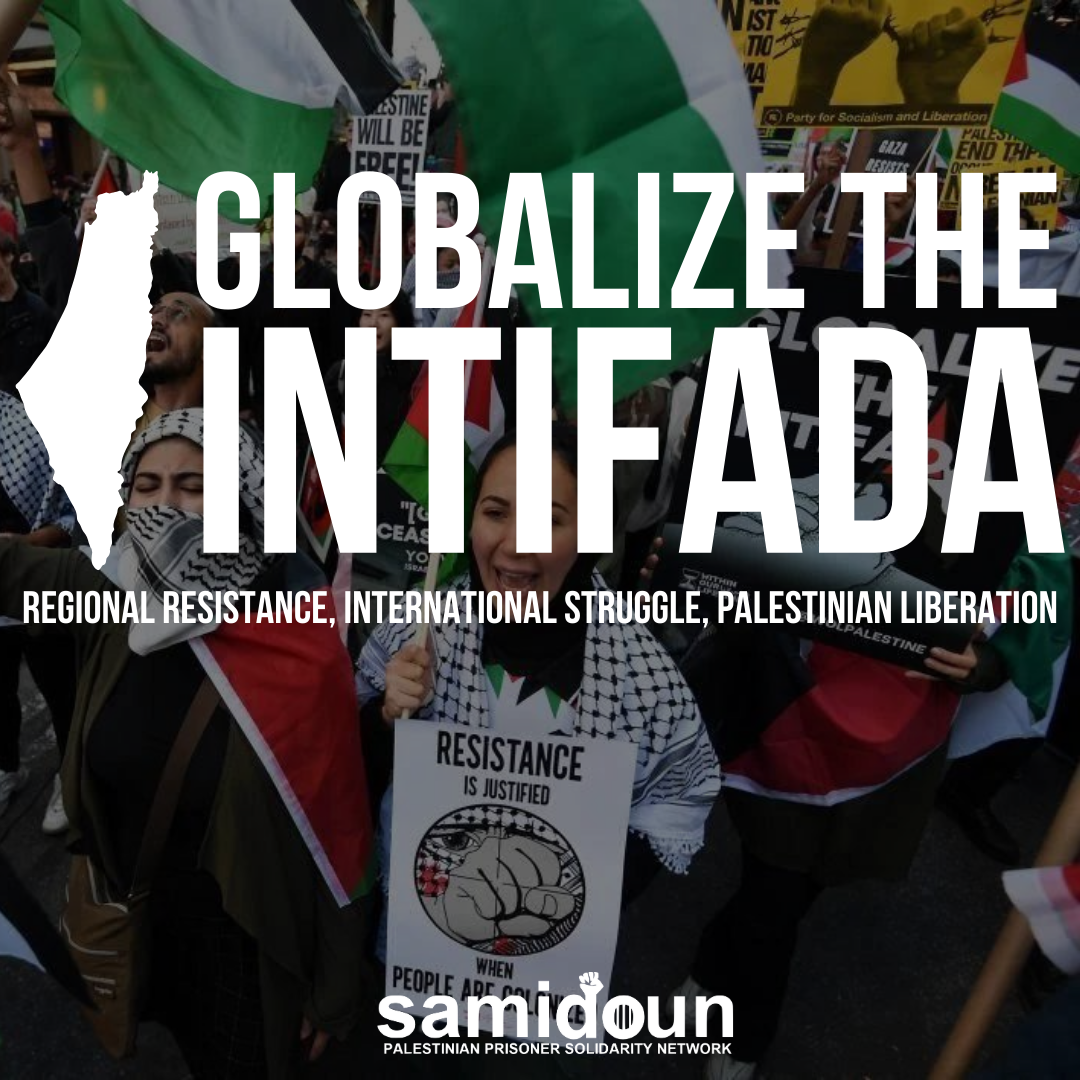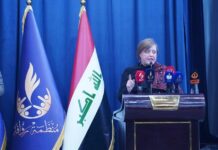
Amid the ongoing genocide in Gaza carried out by the Zionist regime and the heroic resistance of the Palestinian people, December 7-9 2023 marks the 36th anniversary of the launch of the great popular Palestinian Intifada of 1987, one of the longest sustained grassroots uprisings in history and an example, like today’s battle, of the leadership of the Palestinian working class and popular masses in the struggle for the liberation of Palestine against Zionism, imperialism and their reactionary partners in the region. As Palestinians fight, mourn, love and struggle in the face of an all-out U.S./Israeli assault on their lives, existence and future, they not only defend their land and people but stand with their allies in the regional resistance and around the world on the frontlines of a truly globalized Intifada.
The Great Intifada launched from Gaza’s Jabaliya refugee camp, often called Mukhayyam al-Thawra, the camp of revolution. Today, the people of Jabaliya camp, themselves refugees of the 1947-48 Nakba, once again resist displacement and the Israeli attempts to push them to the south of Gaza and then to Sinai in Egypt. They remain firmly rooted in the North of Gaza, living through starvation, torture, massive aerial bombing, siege and invasion in order to resist the genocide of their entire people.
On 8 December 1987, the murder of four Palestinian workers, mowed down by an Israeli occupation army truck in Jabaliya camp, led Palestinians to take the streets in massive numbers, building their movement, collectives and institutions, uniting around the messages of the Unified National Leadership of the Uprising, boycotting Israel and practicing all elements of popular struggle and collective resistance. Today, as we take to the streets once again, 36 years of Intifada stretch forward to the current Palestinian revolution against a barbaric Israeli genocide.
The prisoners’ movement and the Intifada
As we commemorate this 36th anniversary of years of struggle, of the imprisonment of over 600,000 Palestinians, of Yitzhak Rabin’s “breaking bones” strategy reenacted in mass slaughter in Gaza, we are also facing attempts to render the Palestinian struggle unspeakable, even as it is clear that the Palestinian people and their resistance, along with their allies, are not defeated but are instead exacting a significant cost on the occupier, defending their land toward victory, return and liberation despite the genocide.
Today, there are nearly 8,000 Palestinian prisoners locked behind Israeli bars. The prisoners liberated during the one-week “humanitarian pause” by the Palestinian resistance through an exchange agreement relayed the severe situation of the captives today, subject to torture, abuse, malnutrition and mistreatment. Six Palestinian prisoners have been assassinated so far behind bars. Every day, the Zionist regime publishes new propaganda photos of Palestinian civilians being stripped and abused, in an attempt to break the will of the people and their resistance.
In 1987, the Intifada was preceded by the self-liberation of Palestinian prisoners; and in 2023, the prisoners’ movement, its strikes, uprisings and ongoing liberation struggles, has clearly pointed the compass toward return and liberation. In fact, the great Intifada was in many places led by Palestinian prisoners who had been liberated by the Resistance in the great 1985 prisoner exchange; today’s resistance is also led by freed Palestinian prisoners who honed their commitment to the struggle in the “revolutionary schools” established by the prisoners themselves, particularly during the Intifada. There is a direct throughline from 1987 to today, through the prisoners’ movement and its leading role in the collective liberation struggle.
The liberation of the prisoners is so precious to the Palestinian people everywhere that the resistance is unwilling to exchange its prisoners of war for anything other than the liberation of the imprisoned heroes of the Palestinian people in Zionist jails, on the terms of the resistance, despite the genocidal bombardment.
The liberation of the prisoners – including those held in international imperialist jails, like Georges Abdallah in France; the Holy Land Foundation prisoners Shukri Abu Baker, Ghassan Elashi and Mufid Abdulqader in the United States; and Amin Abu Rashed in the Netherlands – is once again central to today’s global intifada.
The globalized Intifada
“From New York to Gaza…From Vancouver to Gaza….From Berlin to Gaza…From London to Gaza…From Cape Town to Gaza…From Sao Paulo to Gaza….From Paris to Gaza, Globalize the Intifada!”
The call rings out around the world, as hundreds of thousands – indeed, millions – march against the ongoing Zionist genocide against the Palestinian people in Gaza. This phrase is not only an expression of sympathy with the Palestinian people and their heroic resistance fighting by all means for the liberation of Palestine, but also a reflection of the international, Arab and Palestinian nature of the Palestinian cause.
Today, the regional resistance is on the front lines of this globalized Intifada that presents a meaningful potential for sweeping the Arab region free of U.S.-led imperialism, including its European and British partners. It is worth recalling that, prior to the 1987 launch of the Intifada, the Palestinian cause seemed at a desperate point, at risk of liquidation, after the Palestinian resistance had been forced from Lebanon under Zionist invasion, while the camps were under siege. The Intifada came to reorient the compass and set the liberation struggle once again on a clear path forward.
Once again, today, prior to 7 October, the drive toward normalization with the Zionist regime seemed inevitable to many, while others bemoaned the disunity of the Palestinian movement; the struggle today has, once more, clarified the role of all forces in the region and the world, uniting the Palestinian people and their Arab and international allies toward liberation and return.
Palestine to Yemen to Lebanon and Beyond: Regional Resistance, Regional Revolution
In Yemen, the mobilized Yemeni people and their armed forces have shut down the Red Sea to Zionist naval traffic after seizing the “Galaxy Leader” ship owned by an Israeli businessman. They have consistently taken action to directly intervene in support of Palestine, imposing a truly material economic cost on the Zionist regime. The Yemeni people and their armed forces have brilliantly illustrated their own triumph over years of siege imposed by reactionary Arab regimes at the behest of Zionism and imperialism through this substantive form of boycott, divestment and sanctions: isolating the Zionist regime and advancing real Arab sovereignty over land, water and resources.
The people of Yemen are, of course, joined in this Intifada by the Lebanese Resistance, who through their participation in the battle of Al-Aqsa Flood, in the resistance to the genocide, have imposed significant military, economic and social costs on the Israeli regime. Over 20 years after the liberation of the South of Lebanon in May 2000 – one of the major factors in sparking the Al-Aqsa Intifada that began in 2000, often called the “Second Intifada”, the Lebanese Resistance is a full partner of the Palestinian Resistance on the field of battle and on the strategic level, enacting the unity of all fronts in order to confront the alliance between “Israel” and the imperialist forces, led by the United States alongside Germany, France, Britain, Canada and their partners. This regional alliance of resistance stretches from Palestine, Yemen and Lebanon, to Iraq, where the U.S. bases remain under ongoing fire and resistance to finally bring that occupation to an end, to Syria, Iran and beyond.
The international popular cradle of the Resistance
Everywhere around the world, the broad masses of the people, from the heart of the Global South to the center of the imperial core, are expressing a clear and thorough rejection of the ongoing genocide that has quickly accelerated to a firm revulsion to the Zionist ideology and Zionist project as a whole and to solidarity with and inspiration by the Palestinian people and their heroic resistance in all forms, particularly the armed resistance. The “red triangle” over targets featured in the resistance videos of Al-Qassam Brigades, Saraya al-Quds and other resistance forces has become an online shorthand for the triumph of the people, their determination, their love for their land and their community over the automated, technologized forces of death and destruction represented by the Merkava tanks and military bases of the US/Israeli war machine.
The “Dahiyeh doctrine” of mass destruction of civilian lives and infrastructure failed in Lebanon in 2006 because the people were a popular cradle, a source of nourishment, growth and sustenance, of the resistance, because the resistance was of, by and for the masses; today, it is failing once again in its full genocidal furor in Gaza for the same reason. This Resistance emerges from the very camps of refugees, denied their right to return home for the past 75 years, that the Zionists seek to destroy and drive into a new displacement today. Globalizing the intifada today means developing the international popular cradle of the resistance – the growing recognition that the Resistance of the Palestinian people, joined by their comrades, brothers and sisters in Yemen, Lebanon, Iraq and beyond, today represent the hope of humanity on our collective front lines.
Like the great popular Intifada of 1987, today’s Palestinian, Arab and international globalized intifada is an anti-imperialist cause. It is a movement against colonialism, imperialism, racism and oppression everywhere. The Palestinian flag is not only a symbol of Palestinian national liberation, but of a commitment to anti-colonial principles, to Indigenous sovereignty, to the fight against exploitation, to the fight to end the extraction of wealth, labour and resources by the United States and its imperialist cohort in Europe.
The anti-imperialist nature of the Palestinian cause has perhaps never been more clear than in the present day, where every imperialist power has clearly aligned itself with the Zionist regime with unparalleled fervor, sending billions of dollars in weaponry for genocidal aerial bombing of the Palestinian people in Gaza; banning demonstrations and Palestinian and Palestine solidarity organizations, including Samidoun in Germany; arresting and prosecuting demonstrators and organizers in France, the United States, Canada and elsewhere; setting up new parliamentary and congressional bodies meant to silence and suppress the growing movement and releasing a torrent of deceptive propaganda; and unleashing a wave of social terror in the academy. It is clear that the imperialist powers are doing this because they see the events of October 7 and the rising regional and global resistance as a threat to their continued domination and extraction of wealth from the region and view the Zionist regime as their mechanism to hold on to such power through genocidal violence.
The imperialist powers, led by the United States, have always viewed Zionism as a mechanism to extract wealth from the people of the region while denying the Arab nation sovereignty over its land, wealth and resources. From the Zionist colonization of Palestine, directed by Britain, through the Nakba, the 1967 occupation, the Intifada to the Zionist genocide today, the imperialist powers have always been the central enemy of the Palestinian people, and every rock, every bullet and every strike that confronts “Israel” also confronts imperialism.
Today’s international popular cradle of the resistance, this globalized intifada, stretches from Gaza, Sanaa, Beirut, Baghdad and Damascus to the streets of Havana, Caracas, Sao Paulo and Johannesburg to the heart of the imperial core, raising a collective voice and developing an international struggle against imperialism and its murderous wars, sanctions and siege, with Palestine at the center.
The working class and the masses lead the struggle
Also like the great Intifada of 1987, we are in a clear era of unity of the Palestinian cause despite the lingering near-afterlife of the collaborationist Palestinian Authority in Ramallah. The Palestinian people throughout occupied Palestine and everywhere in exile and diaspora are united to bring an end to the genocide, unified behind the Resistance, forming a global resistance front that also embraces popular mobilization, arts, culture, political engagement and grassroots organizing as central to the liberation struggle. On this 36th anniversary, we recall that the siege of the camps in Lebanon was finally broken by the eruption of the Intifada inside occupied Palestine in 1987. Today, we look forward to breaking the siege on Gaza, not only through the strength and resilience of the Palestinian people in Gaza, but through the uprising elsewhere and everywhere.
The popular leadership of the working class, based in the unions and organizations of Palestinian workers, farmers, peasants, women, students, fishers, teachers and other social sectors, was central to the development of the Intifada of 1987, a highly organized movement that governed its activities through committees, strong political representation, and central statements that nonetheless provided for widespread popular participation and meaningful engagement in the revolutionary cause.
The Palestinian masses have risen up time and again in revolutionary struggle; even between 1987 and today, we see the second Intifada and upsurge after upsurge, confronting the ongoing home demolitions, land confiscations, mass imprisonment, colonial settlement, killings, denial of the right to return, uniting Palestinians inside and outside occupied Palestine.
Today’s Resistance is a highly organized movement, today led by the Islamic resistance movements in direct alliance with the revolutionary left and Palestinian national forces. It involves the participation of not only the Palestinian people in Gaza and throughout occupied Palestine, but everywhere in exile and diaspora, fighting, organizing, speaking and revolting for liberation and return. Its base is once again deeply rooted in the working class and popular masses of Palestine, as it always has been, from the 1936 revolution to the post-October 7 Palestinian revolutionary struggle. It has always been the workers, peasants and refugees of Palestine who have led the movement, who have given thousands upon thousands of martyrs, who have spent years upon years in prison, and who have raised young strugglers to fight generation after generation until total liberation.
The war on the Intifada
From members of U.S. Congress, to university officials, to German security services, to British police, to the French interior ministry, imperialist forces are attempting to criminalize, suppress and silence clear speech for Palestine. They seek to turn reality inside out, whereby “intifada” – the term reflecting resistance to genocide and oppression – is redefined as itself “genocidal.” These propaganda campaigns aim to empty the term “genocide” of meaning and legal weight and to attempt to reclaim control over the discussion of the Palestinian cause, a control that has been swept away by decades of struggle, and has been rendered unrecoverable after October 7. They also seek to target the growing role and organization of Palestinians in exile and diaspora, reclaiming their role in their national liberation movement stripped from them through the years of the Oslo liquidation process.
From the river to the sea, Palestine will be free. Long live the Intifada. Victory to the Palestinian Resistance. Stand with the Palestinian armed struggle. Zionism is racism. Imperialism will be defeated. These slogans are ringing out everywhere around the world, and now is the time to declare them, more loudly and clearly than ever. There are no slogans or statements that will satisfy Zionism and imperialism – on the contrary, they wish to strip our movement of our most effective advocacy and our most unifying vision, the vision and promise that enables people to continue to fight, to resist, and to move toward victory in the most extreme conditions of genocide and deprivation.
The great popular Intifada that began in 1987, the great sacrifices and accomplishments of the Palestinian people, were confiscated by U.S. imperialism and Arab reactionary regimes in alliance with a sector of the Palestinian ruling class. This came first through the Madrid conference of 1991 and then by the notorious Oslo accords signed in Washington, D.C., in 1993, a liquidationist attempt to transform the revolutionary aspirations of the Palestinian people into a mere self-rule project adjacent to Zionist colonialism. It developed amid dangerous international conditions – from the fall of the Soviet Union and the Eastern bloc states, the threat of US imperialism dominating a unipolar world, and the first Iraq War and the attack on Arab self-determination.
Today, as the U.S. casts its veto in the United Nations against a ceasefire in Gaza, voting for ongoing genocide, it declared that the bombing must continue because Hamas, and thus the Palestinian Resistance, “does not accept a two-state solution.” Indeed, the strugglers of today have learned the bitter lessons of the past diversion of their cause and reliance on the primacy of imperialism, with the U.S. as a “broker.”
Today’s Intifada, on all levels, the Arab, regional, and international Intifada, against a genocidal enemy fully revealed in its atrocities before the world, has only one path forward: no cooptation, no normalization and no concessions, but the defeat of Zionism and the liberation of all of Palestine, the central key for the liberation of the entire Arab nation and the broader region from U.S.-led imperialism and its agents.
On the 36th anniversary of the continuing Intifada, amid today’s global Intifada against genocide, Zionism and imperialism, in honour of all those who sacrificed and fought for freedom, in salute to the over 17,000 martyrs of Gaza, Samidoun Palestinian Prisoner Solidarity Network pledges to continue the struggle – until return, until liberation, from the river to the sea.
This is a statement of Samidoun internationally, and not necessarily of any particular country or chapter.
Posters of the intifada below:
Posters of the Great Palestinian Intifada
The posters below convey only a portion of the creativity, vision and collective power of the continuing intifada, inside Palestine, among Palestinians in the camps, in exile and diaspora and among Arabs and internationalists. Most below are republished from the Palestine Poster Project:
































![]()




Discover more from Samidoun: Palestinian Prisoner Solidarity Network
Subscribe to get the latest posts sent to your email.




